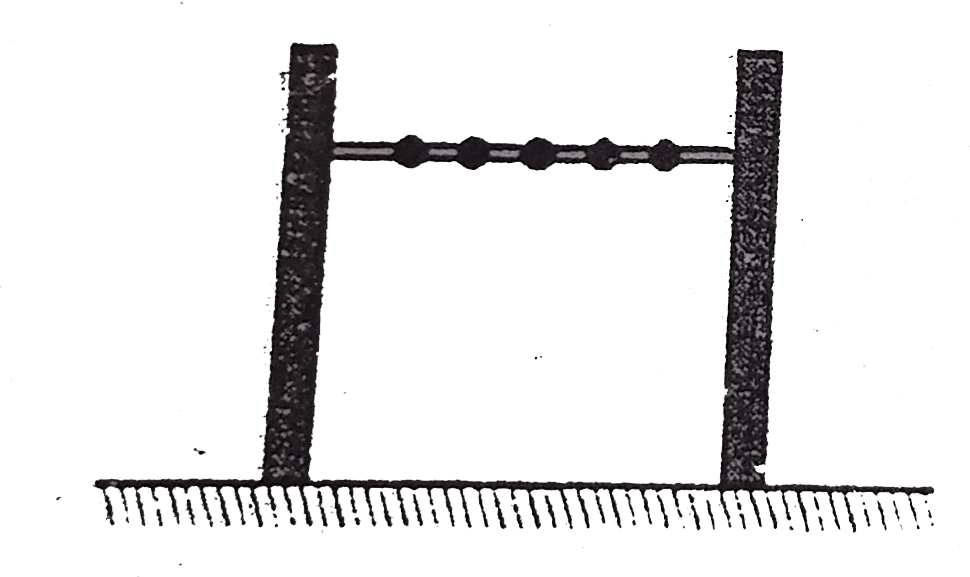Five identical balls each of mass m and radius r are string like beads at random and at rest along a smooth rigid horizontal thin rod of length L mounted between immovable supports Assume 10r≤L and that the collision between balls or between balls and supports are elastic if one ball is struck horizontally so as to acquire a speed v the average force felt by the support is

mv22(L−nr)
mv2L−2nr
mv2L−nr
zero
Step by step video & image solution for Five identical balls each of mass m and radius r are string like beads at random and at rest along a smooth rigid horizontal thin rod of length L mounted between immovable supports Assume 10rleL and that the collision between balls or between balls and supports are elastic if one ball is struck horizontally so as to acquire a speed v the average force felt by the support is by Physics experts to help you in doubts & scoring excellent marks in Class 11 exams.
Updated on:21/07/2023Topper's Solved these Questions
Similar Questions
Two identical tennis ball of mass m and charge q are hinged by a common support with help of a string of length 'l'. If system is in equilibrium then find distance between balls? ignore gravitational interactions between balls. (θ is very small)
View SolutionTwo identical balls each of mass m interconnected by a small light inextensible string are kept on a smooth horizontal surface. One of the balls is pushed towards the other with a speed v0 find the loss of K.E. of the ball. What will be the final velocities of the balls ? (e=1).

View Solution
Knowledge Check
A large number (n) of identical beads, each of mass m and radius r are strung on a thin smooth rigid horizontal rod of length L(L>>r) an dare at rest at random positions. The rod is mounted between two rigid supports (see figure). If one of the beads is now given a speed v, the average force experienced by each support after a lone time is (assume all collision are elastic) :-
 Amv22(L−nr)Bmv2L−nrCzeroDmv2L−2nr
Amv22(L−nr)Bmv2L−nrCzeroDmv2L−2nrTwo identical balls, each of mass m, are tied with a string and kept on a frictionless surface. Initially, the string is slack. They are given velocities 2u and u. in the same direction. Collision between the balls is perfectly elastic.

What is the final in kinetic energy of the balls?Amu2/4Bmu2/2C3mu2/4Dnone of theseTwo balls each of mass 'm' are moving with same velocity v on a smooth surface as shown in figure. If all collisions between the balls and balls with the wall are perfectly elastic, the possible number of collisions between the balls and wall together is
 A1B2C3DInfinity
A1B2C3DInfinity
Two balls each of mass 'm' are moving with same velocity v on a smooth surface as shown in figure. If all collisions between the balls and balls with the wall are perfectly elastic, the possible number of collisions between the balls and wall together is

View SolutionTwo identical balls, each of mass m, are tied with a string and kept on a frictionless surface. Initially, the string is slack. They are given velocities 2u and u. in the same direction. Collision between the balls is perfectly elastic.

After the first collision, what is the total loss in kinetic energy of the balls?
View SolutionTwo identical balls, each of mass m, are tied with a string and kept on a frictionless surface. Initially, the string is slack. They are given velocities 2u and u. in the same direction. Collision between the balls is perfectly elastic.

What is the impulse generated in the string during the second collision?
View SolutionThree identical balls are connected by light inextensible strings with each other as shown and rest over a smooth horizontal table. Length of each string is l.
At moment t=0, ball B is imparted a velocity v0 perpendicular to the strings and then the system is left on its own.

If collision between the balls is completely inelastic, then
View SolutionTwo smooth balls A and B, each of mass m and radius R, have their centers at (0, 0, R) and at (5R, -R, R) respectively, in a coordinate system as shown. Ball A, moving along positive x axis, collides with ball B. Just before the collision, speed of ball A is 4m/s and ball B is stationary. The collision between the ball is elastic.

Impulse of the force exerted by A and B during the collision, is equal to
View Solution
